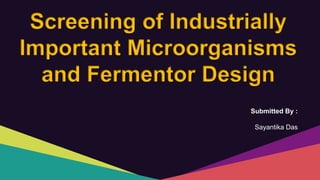
Screeneing of industrially important organisms and fermenter design
- 1. Screening of Industrially Important Microorganisms and Fermentor Design Submitted By : Sayantika Das
- 2. CONTENTS Screening of Industrially Important Microorganisms Types of Screening Primary Screening Secondary Screening Principle of Fermentation Process Basic Fermentor Design
- 3. Screening of Industrially Important Microorganisms The detection and isolation of microorganisms from a natural environment like soil containing a large no. of microbial population is known as screening. The screening of microoranisms deals with the economics of fermentation process. Types of Screening Primary Screening Secondary Screening
- 4. Primary Screening It’s a process for detection and isolation of microorganisms of our interest. Determines which microorganisms are able to produce a compound. Does not provide much idea about the production or yield potential of microorganisms. It separates out only a few microorganisms, which have commercial value while discards the valueless microorganisms .
- 5. Types of Primary Screening Indicator Dye Technique Crowded Plate Technique Auxanographic Technique Enrichment Culture Technnique Organic acid Producing Microorganisms Antibiotic Producing Microorganisms Extracellular Metabolite producing Microorganisms Defined Media Microorganisms
- 6. Types of Primary Screening Indicator Dye Technique Crowded Plate Technique Auxanographic Technique Enrichment Culture Technnique Organic acid Producing Microorganisms Antibiotic Producing Microorganisms Extracellular Metabolite producing Microorganisms Defined Media Microorganisms i. Certain pH indicator dyes are used in the agar medium. ii. Eg. Neutral Red, Bromothyol Blue iii. Organisms pertaining to that particular acidic pH will respond to the corresponding colour during their growth. iv. Subculturing.
- 7. Types of Primary Screening Indicator Dye Technique Crowded Plate Technique Auxanographic Technique Enrichment Culture Technnique Organic acid Producing Microorganisms Antibiotic Producing Microorganisms Extracellular Metabolite producing Microorganisms Defined Media Microorganisms i. Proceeds by serial dilution and plating of the suitable aliquot. ii. Antibiotic producing colony will have no bacterial growth around it. iii. Subculturing.
- 8. Types of Primary Screening Indicator Dye Technique Crowded Plate Technique Auxanotrophic Technique Enrichment Culture Technnique Organic acid Producing Microorganisms Antibiotic Producing Microorganisms Extracellular Metabolite producing Microorganisms Defined Media Microorganisms i. We take a test organism which utilises that particular metabolite and make a suspension culture of it in that particular metabolite. ii. Serial dilution of the sample containing microorganisms. iii. The culture plates are flooded with the suspension culture of test organism.
- 9. Types of Primary Screening Indicator Dye Technique Crowded Plate Technique Auxanographic Technique Enrichment Culture Technnique Organic acid Producing Microorganisms Antibiotic Producing Microorganisms Extracellular Metabolite producing Microorganisms Defined Media Microorganisms i. Used for growth of organisms which are not easily found. ii. serial dilution. iii. Grown on specific nutrient media.
- 10. Secondary Screening Secondary screening, which can provide broad range of information pertaining to the: Ability or potentiality of the organism to produce metabolite that can be used as an industrial organism. The quality of the yield product. The type of fermentation process that is able to perform. Elimination of the organisms, which are not industrially important.
- 11. Secondary Screening Methods Solid Media Liquid Media **Used for isolation and detection of those antibiotics, which diffuse through solid medium. 1. Giant Colony Method > Organism such as Streptommyces is grown on agar medium. > Checked using test organism having antibiotic sensitivity.
- 12. Secondary Screening Methods Solid Media Liquid Media i. more sensitive because it provides more useful information about the nutritional, physical and production responses of an organism to actual fermentation production conditions.
- 13. Secondary Screening Methods Solid Media Liquid Media 1. Filtration Method example - The Streptomyces is grown in a broth and its mycelium is separated by filtration to get culture filtrate. 2. Liquid Medium Method: This method is generally employed for further screening to determine the exact amount of antibiotic produced by a microorganism like Streptomyces.
- 14. Principle of Fermentation Fermentation is a biochemical process in which certain organisms are used to breakdown organic molecules to produce food, pharmaceuticals and alcoholic bevarages on a large scale. The basic principle involved in the industrial fermentation is that organisms are grown under suitable conditions, by provoding raw materials meeting all the necessary requirements such as Carbon, Nitrogen, Salts, Trace Elements and Vitamins.
- 16. Basic Fermentor Design Impellers are an agitation device.
- 17. Basic Fermentor Design break the vortex formed during agitation process by the impellers.
- 18. Basic Fermentor Design fermentation media, inoculum and substrate are added in the fermentation tank.
- 20. Basic Fermentor Design withdrawal of samples to monitor fermentation process and quality control.
- 21. Basic Fermentor Design adjusts the pH to its optimum level by addition of acids or alkalis.
- 23. Thank you